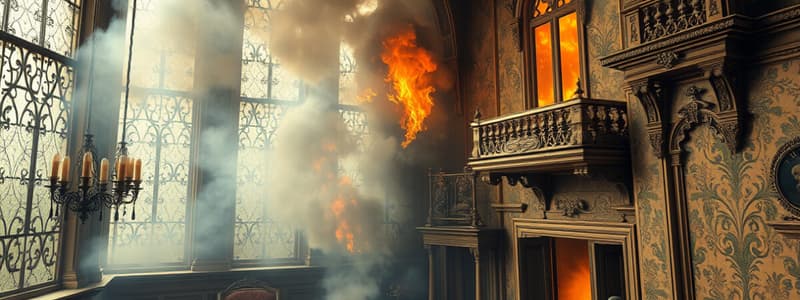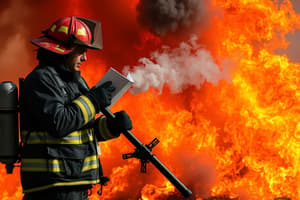Podcast
Questions and Answers
What is the primary purpose of positive pressure ventilation (PPV) during active fire stages?
What is the primary purpose of positive pressure ventilation (PPV) during active fire stages?
- To clear smoke from the area (correct)
- To prevent smoke from entering the building
- To remove heat from the structure
- To cool down the building's air handling system
Which action is recommended to prevent smoke damage during ongoing ventilation efforts after fire control?
Which action is recommended to prevent smoke damage during ongoing ventilation efforts after fire control?
- Leave ventilation systems running continuously
- Use fans to circulate smoke throughout the structure
- Close or open doors strategically (correct)
- Open all windows to allow fresh air in
Why is it important to avoid blowing smoke throughout the structure during overhaul?
Why is it important to avoid blowing smoke throughout the structure during overhaul?
- It enhances the visibility for firefighting operations
- It prevents the air handling system from becoming contaminated
- It can help extinguish residual flames quickly
- It may worsen the conditions for search and rescue (correct)
What should be done with smoldering materials during the overhaul phase?
What should be done with smoldering materials during the overhaul phase?
What is a potential risk of leaving the ventilation system running after extinguishing a fire?
What is a potential risk of leaving the ventilation system running after extinguishing a fire?
Flashcards are hidden until you start studying
Study Notes
Smoke Damage Mitigation
- Hot smoke from a fire spreads throughout the structure unless controlled.
- Positive Pressure Ventilation (PPV) is used during active firefighting to clear smoke.
- Post-fire measures include managing door openings to reduce smoke damage while ventilating.
- Roof ventilation (cutting a hole) is recommended to facilitate smoke removal.
- Quick smoke removal enhances firefighter effectiveness in search, rescue, and salvage operations.
- After extinguishing the fire, it is critical to remove remaining smoke to prevent further contamination.
- Avoid redistributing smoke throughout the building; maintain ventilation during overhaul procedures.
- Smoldering items, like couches, should be taken outside for safe disposal during cleanup.
- In certain situations, it is important to turn off the building's ventilation system to prevent air contamination.
- Air Conditioning (AC) systems can spread smoke and contaminants, posing risks to the air handling system, which may necessitate its replacement.
Studying That Suits You
Use AI to generate personalized quizzes and flashcards to suit your learning preferences.




